Reaching People
An assessment of the ideals of the project and their implications
by John Doorty
The immediate effect of the individual aspects of the project as implemented in Ennistymon has been very well documented in the preceding chapters. But it is now time to reassemble the various activities so as to examine the project in the light of an overall achievement, and attempt to evaluate its significance for the future of Community Arts in Ennistymon and, indeed, in Ireland.
These aims and indeed the inspiration of the project must again be stated. As conceptualised by Marian Fitzgibbon, the project sought to rectify the imbalanced concentration of the visual arts in Ireland's cities and proposed instead to revitalise a rural community by (a) encouraging people living in Ennistymon to experience creativity in the visual medium, and (b) to provide them with an opportunity to see and appreciatee contempor- ary art.
The harmonious effect was to be an introduction to visual art, leading to changed attitudes about this form of expression. People were as a result to be more visually aware of the town and its environs, and to be enriched artistically and socially through involvement in the project. They were to see a tangible improvement in the environment as the project progressed. And all these achievements were to be celebrated in a Visual Arts Festival in August.
(A) ENCOURAGING CREATIVITY
The main thrust of the project i.e. an eight month period from January 1984 to August 1984, encouraged local creativity and involvement in murals, a sculpture playground, many exhibitions and workshops, and in a more subtle way in the "Just Looking" exhibition. These methods by which most of the ideals of the project were to be realised were given concrete expression right from the start.
Firstly, they were nurtured in a smaller group of people identified as community conscious and active, as there had been no previous organised art group per se- though there was a group of artists and craft workers settled in the area who identified immediately with the project. Also, the structure of the project, and its presentation through Una McCarthy, as a professional administrator, was such as to make it successfully accessible to others with a less artistic background. This was all important.
When the project got underway, with the Children's "Paint-in", and the "Old Photographs" exhibition, there were no fears that any section of the community could feel alienated in any way. In fact the Old Photographs exhibition in January 1984 yielded up its own vital lesson to the organisers which was capitalised on throughout the project. That is the necessity to begin with material close to people's visual experience. In this case people were asked to contribute photographs which they themselves would select for the exhibition. Family portraits and photos of local events were put on display, giving them a significance that was appreciated by the entire community.
The Textile and the 'Printed Matter' exhibitions which followed were based on the same principle. These exhibitions, while not part of the original proposal, but developed from it, helped to give the community an understanding of what the project was about and encouraged an appreciation of local arts and crafts.
Unfortunately, encouraging people to more creative participation in an art or craft workshop did not prove as successful, as we were to discover in our series of workshops. The main problem encountered here, for which the momentum of the project was not geared to cater, was the in-bred lack of confidence in the individuals creative ability. A once-off introductory workshop which we offered in various arts and crafts could not hope to seriously address the issue. However, our experience with the project does highlight the need for the schools and community arts organisations to provide a much needed opportunity for everybody to experience creativity in as many media as possible.
In Ennistymon's case, active participation in the workshops was seen to lead to greater appreciation of the work of the skilled craftsperson or artist involved. And workshops did have a greater appeal for the teenage and younger age groups. This illustrates that if attitudes can be changed then much can be done particularly with young people who will hopefully become the new art audience. There is need, though, for ongoing effort in this regard.
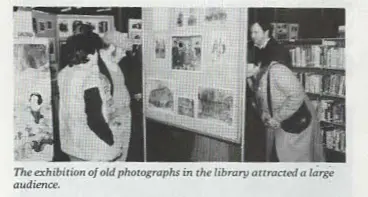
The exhibition of old photographs in the library
LEVELS OF INVOLVEMENT
While creative involvement as part of an educational process is a long term objective, the cultural effects of which will not be apparent for some time, more immediate reaction was forthcoming from a greater cross section of the community to the murals and the Sculpture Playground. These schemes reflected more the kernel of the project combining as they did to improve the environment and involve many sections of the community in so doing.
By involvement here we mean more than the creative part taken by the children and teenagers who painted the murals, but also the response from the community at large due to the direct and everyday confrontation with the art-work. The initial reaction was, naturally, to the novelty of the whole exercise, and then as the murals neared completion onlookers expressed surprise at the children's ability, under supervision, to produce something strikingly visual.
There is no doubt also that the Ardnaculla and Library murals helped to make Ennistymon '84 succeed at many levels; encouraging creative expression in young people, challenging traditional ideas about art, enhancing neglected sites, initiating discussion at community level on the project and providing motivation to improve the environment. Also, these murals have demonstrated that the Arts Council's 'Paint on the Wall' scheme (on which the murals were based) should be developed outside the school and at community level.
The benefit of murals however to Ennistymon is temporary. After a while they blend into the scenery of the town and the consciousness of the people and they can become just as neglected and run-down as that which they set out to enhance in the first place. Therefore, I think it necessary, as has already occurred with the Library mural, that the creative experience be rekindled and that the murals be painted out and replaced with a fresh idea. Or as in the case of Pat Barrett's mural in the Community Centre the artist himself will retouch it to protect it from the ravages of time. The Sculpture Garden by Maurice Quillinan, on the other hand, will remain a permanent monument in stone to the whole project. For this reason the space around it needs to be landscaped and maintained.
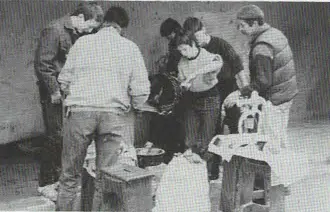
INTEGRATION OF RESOURCES
A contributing factor to the success, permanent or otherwise, of some of the major schemes of the project was the finance available at the time. Beginning with absolutely no budget we got by on the resources of time and talent invested by the artists and people involved. Later public funding came from the Arts Council so murals, "Just Looking" exhibition, etc., could go ahead. In granting the entire estimate of £8,850 submitted for the project the Arts Council showed the height of encouragement for the scheme, particularly at a time when there was financial constraints on the funding available to the arts in general.
One scheme which did not require Arts Council funding was the Sculpture Playground, as it was intended - almost naively that it would be furnished by sponsorship in kind, local materials and voluntary labour. In the end the playground structure, designed by Mike Fitzpatrick, was built in Ardnaculla with the amalgamated assistance of AnCO, Clare Co. Council, Ennistymon '84, local unemployment, Mid-West Arts and lots of local enthusiasm and support, with the back-up of facilities and administrative personnel in an Arts Office funded by the Y.E.A.
That this project is unique in introducing art as a practical everyday element of a children's playground, and a necessary amenity to the housing estate, is without question. But that so many groups, public and private, could interact to make it happen was both phenomenal and unprecedented in the arts in this country. It reflects the dynamic spirit which the project had generated locally, and was capable of bringing to bear on the community in the wider sense. It demonstrates also the effect the arts can have in breaking down bureaucratic barriers when motivation is coming from within the community itself.
Yet, in spite, or maybe because of, this unique involvement, decisions on the future maintenance of the playground have not been taken by any of the interested parties.
On the positive side, it means that a role has been established for the arts within the community, and that in Ennistymon - from its experience of the Sculpture Playground and the 'Just Looking' exhibition - that role is associated with the development of the town in general. The way in which the Community Arts Committee, set up in the aftermath of Ennistymon '84, is attempting to maintain and achieve this aim by working with and through other groups within the town; and certainly by continuing the motivation begun in 1984 on the bases of combining the needs of the community and the interest of Clare Co. Council in the playground.
(B) SEEING CONTEMPORARY ART
The integration of the visual arts into the everyday life of the town as a thing of play, as a thing of work, as a thing of entertainment and as a thing of improvement continued with the presentation of contemporary art in a formal way also. Particularly as there are no purpose- built galleries in Co. Clare many Ennistymon people have never been to an exhibition or visited a gallery. This kind of inaccessibility has been shown in the 1980 survey of the arts in Munster, Audiences, Acquisitions, and Amateurs', to be part of the problem facing the arts in rural Ireland, where only 9% of the population attended an exhibition of painting or sculpture in 1980/81. It is suggested that the main reason for these low figures is cultural.
The low-key reaction in Ennistymon to work in the "Sources" exhibition, and indeed to the more abstract work of some of the local artists, corroborates this; and indicates that the educational process towards appreciation is a long and varied one. This is not to say that the local artists who gave workshops and later had a show of their work did not receive recognition from the community. But the difficulty for the audience to come to terms with their non-representational art-work, in such a short period, proved too great.
Some of the work would have benefitted the
audience more had the artists been encouraged to promote their work and, dare I say it, 'explain' it to the public. However, the emphasis in the Ennistymon '84 project was on the confrontational or 'art attack' elements of the project; such as the Just Looking exhibition, which were found to be more successful in terms of community involvement and measurable audience response.
Of course, the lack of facilities and proper venues did influence both the standard of presentation and the level of response. And if artists are to be encouraged to display their work locally, then to do justice to it, there is need to provide the necessary facilities. A 'temporary' gallery, or a venue shared with other cultural interests would be an advantage to the town. And it is something which Ennistymon Community Arts is hoping will be achieved in the restoration of the old Protestant Church by the Ennistymon and District Comhaltas Ceoltoiri Eireann branch.
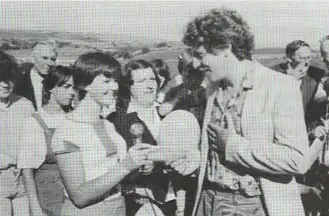
The mothers of Ardnaculla making a presentation to Mike Fitzpatrick
TERMS OF REFERENCE
The Just Looking exhibition, by turning the whole town into a gallery, showed what can be achieved with what is available. It represents the climax of the whole project, the planning for which went on throughout the year, both directly and indirectly, through the earlier events. Significantly, therefore, it combined the notion of encouraging creativity (the shopowner discussing the theme of the display with the artist), with the introduction of contemporary art (the artists finished work on display in the shop window). The important element in this exhibition was the audience, i.e., everybody who visited the town in the normal course of two weeks in Ennistymon, and who were confronted with the work. Naturally, because the familiar environment had been transformed in some cases overnight - people had to come to terms with the change. They discussed the work with the shop owner, they made decisions, and they picked favourites in relation to their situation and theme, rather than in relation to the artist who executed it. The exhibition elicited this kind of response because of the demands placed on the artists also. One artist described it thus, "... as a painter I was used to working from internal demands as a starting point for my work, but here in Ennistymon, I was forced to reconsider and question my approach totally. In a way it was more like a designers brief - getting the message across and doing it within my method of working".
The end result of this endeavour was accessibility to the arts on a grand and dramatic scale, incorporated into an arts festival which attracted nation-wide attention. In turn the notice of the media, the tourist, and the artist created a euphoric atmosphere which was possible unprecedented in the recent history of the town. All of this contributed to the underlying motive of the exhibition in focussing the attention of the native on the visual character of the town, viz. the traditional shopfront, which is an intrinsic quality deserving of preservation.
An encouraging indication of the success of the exhibition at this level was the example set by the shop owners who commissioned artists, or did their own displays for the exhibition - suggesting that an annual "shop window display competition" would continue to promote local creativity, visual awareness and pride in the town. There was also the very rewarding feeling of achievement on seeing two shop owners, reportedly modernising their premises, decide instead not alone to preserve but also restore; and a third premises, no longer a shop but which featured in the exhibition, afterwards had its front expertly painted to bring out the detail of the wood.
A similar upsurge in civic pride, which can only indicate the success of any community based project, was noticed with the murals and the Sculpture Playground - though these projects were more localised, and in the case of the playground a benefit to the Ardnaculla community alone. But the artistic enterprise of the Just Looking exhibition, at the centre of town life was all embracing.
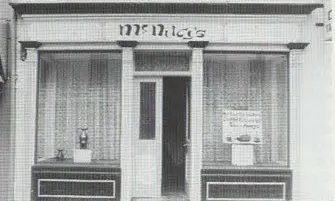
BROADENING THE BASE
As anybody who was present at the opening of the festival on August 13 will agree, the cross section of people present farmers, shopkeepers, artists, celebrities, children - represented the entire community. This is in marked contrast to established tradition elsewhere at exhibitions where there is a sectional or middle-class interest - particularly on opening nights. Ennistymon '84 consciously set out to make exhibitions a community event combined with music and entertainment, and anywhere visual art has been presented in a similar fashion, such as in supermarkets or shopping centres, it has always been a success from the point of view of audience.
The indication is that the need for Community Arts exists because there is an educational and social need there to see that the audience which has little or no previous interest in the arts is now affected by it. Or - as we would say of the project in Ennistymon everyone has been touched' by it in some way. However, questions like, "are we reaching enough people?", with which the Ennistymon '84 committee examined its conscience regularly, need to be asked at national level also.
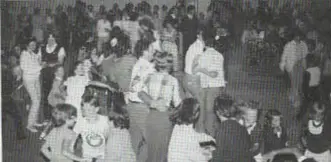
A section of the Community Centre crows taking part in the festivities
CONSOLIDATING ACHIEVEMENTS
Unfortunately, opportunities to work with the community at large, as in the Just Looking exhibition, are not frequent. Our community artists approach to their task was to select particular groups within the community. Liz McMahon chose to work with teenagers, on the one hand, in the building of a puppet theater, and old folks in a geriatric home, on the other, in the making of a wall-hanging. Mike Fitzpatrick attempted to help the young unemployed through the medium of the visual arts to become creative, industrious and opportunistic.
Essential to their roles were the natural abilities as Community Artists which Mike and Liz brought to Ennistymon; and testimony to their achievement in a 14 week period from September to December 1984 is a Puppet Club which continues to develop and perform new shows, and one individual from the 'Bowland Mould'
course who makes moulds on a part-time basis.
However, so that worthwhile work such as this might continue, or that new projects with other groups be undertaken, training courses for artists in the skills of working in the community need to be developed. In the near future hopefully Community Artists will be available to work in collaboration with Art Administrators and Arts Organisations, or be placed by Regional or County Arts Officers with specific communities.
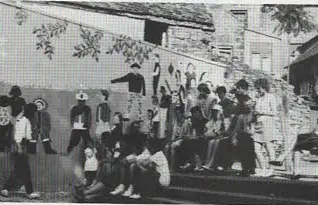
THE AFTERMATH
The projects which the community artists worked on brought a year of intense creative activity to a conclusion. Looking over the 'Chronology of Events', I am reminded that there was a total of over 100 individual events connected with the project. All of these proved very challenging and rewarding, but also very exhausting from an organisational point of view. So much so that some members of the Ennistymon '84 committee felt that they could not commit so much of their family life to the community in such a manner for some time. Nevertheless, most members were enthusiastic about the ideals of continued involvement in the arts in 1985, and Ennistymon Community Arts was formed.
Despite the best intentions for this organisation - so much of which were still wrapped up in Ennistymon '84 business - there was initially an uncertainty in direction, and a feeling that anything attempted would be, inevitably, anticlimactic after Ennistymon '84. While this is a natural consequences of such a hectic year, much is also due to the withdrawal of the administrative support of firstly, Marian Fitzgibbon whose term as Regional Arts Officer was complete; and secondly, that of Una McCarthy, Ennistymon '84 Administrator, who personified the arts in Ennistymon and had motivated the committee.
The story might be different from a committee point of view had the project been planned, and the organisational structures set up to implement it, in the first year of Marian Fitzgibbon's 3 year term in the Mid-West. However, the concentration of the Regional Arts Officer's energies on what could be termed a remote outpost of the Mid-West region is an example of the importance of professional art advisors to the community, and of what can be achieved when there is close personal contact. This will be seen hopefully as a need for Arts Officers on a county basis in the future. The appointment in Clare of its first County Arts Officer in 1985 is a step in that direction.
In any case, now that so much has been done for the most inaccessible of the art forms Ennistymon Community Arts is developing a broader scope in a quieter way into the other art disciplines. In late '84 and in '85 this took the form of performance and workshops by Dublin Contemporary Dance Theatre in dance and movement. And in June Ennistymon Community Arts joined forces with Ennistymon and District Comhaltas Ceoltoiri to celebrate European Music Year with a concert and poster competition.
Of course, Ennistymon Community Arts still has a responsibility to Ennistymon '84- of which this report is a part - and its expertise in the visual arts was important in working with the Ennistymon and Portadown Youth Clubs in a co-operation North-South mural in Ennistymon; for which Ennistymon Youth Club won a special "Enviroventure '85 award. No doubt Ennistymon '84 will continue to be a source of inspiration in the community for many years to come.
CONCLUSION
In so far as I have attempted in this chapter the difficult task of quantifying the overall effect of Ennistymon '84, we must remember that the experimental premise of the project as a whole was to see how a concentrated 'attack' on the visual senses of a community could bring about change and awareness. So, with the emphasis on doing, creating and confronting, within a limited period of time, the effect was immediate and very much part of each event. It has been the intention, and I hope the success of this book, to measure these developments and results throughout and at the time of impact.
Nonetheless, Ennistymon '84' has also left many lasting visual impressions on the Ennistymon people. To those creatively involved in the murals and workshops, Ennistymon '84 has given confidence while also nurturing the latent talents of some individuals. And to those who came into contact with contemporary paintings and sculpture for the first time, the project has effected a significant change in awareness and attitude towards the visual arts.
So too have the structural improvements carried out in the town as part of the project, become the motivation for new community co-operation, individual commitment, and environmental improvement and development. There is now a finer sensitivity to the visual environment of the town-particularly those areas which we must remember that the experimental premise of the project as a whole was to see how a concentrated 'attack' on the visual senses of a community could bring about change and awareness. So, with the emphasis on doing, creating and confronting, within a limited period of time, the effect was immediate and very much part of each event. It has been the intention, and I hope the success of this book, to measure these developments and results throughout and at the time of impact.
But the overall impressive community response in Ennistymon justifies the ideals and the approach of Ennistymon '84; and is recommendation for its adaption in other towns in Ireland. Notwithstanding, of course, the inevitable difficulties many of which may have been the project focussed on-and a greater appreciation of that which is compatible with it. Another welcome attribute of the project, not anticipated in the original proposal but none the less for that, is the effect the involvement of the Arts Council has had on awareness locally about that organisation and its activities. These are all important foundations for the future developments and appreciation of the arts in Ennistymon.
In recommending Ennistymon '84 as a "pilot" scheme for adaption in other towns in Ireland, it is in our opinion the overall impressive community response in Ennistymon which justifies the ideals and the approach of the scheme. Notwithstanding, of course, the inevitable difficulties many of which may have been peculiar to Ennistymon-which such a diverse scheme encounters. Not to be overlooked either, as it is an important feature of the Ennistymon experience, is the way in which the visual traditions of the area were incorporated into the project. This provided the strong cultural link, vital for the community's involvement, and the success of Ennistymon '84 as a whole.
THANKS TO:
Robert O'Byrne, Mid-West Regional Arts Officer. Kay Sheehy, Clare County Arts Officer.
Marian Fitzgibbon, Arts Council Regions Officer